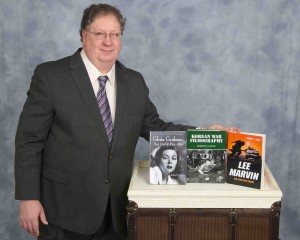 Lee Marvin did not receive his first starring role until he was 40, but in three short years — following the successes of Cat Ballou (for which he won the Academy Award as Best Actor), The Professionals and especially The Dirty Dozen — he was the most popular film actor in America. Marvin was a fascinating man, a loving husband and father, and one of the most natural, effective actors of his time.
Lee Marvin did not receive his first starring role until he was 40, but in three short years — following the successes of Cat Ballou (for which he won the Academy Award as Best Actor), The Professionals and especially The Dirty Dozen — he was the most popular film actor in America. Marvin was a fascinating man, a loving husband and father, and one of the most natural, effective actors of his time.
Lee Marvin: His Films and Career is a comprehensive reference of the Oscar-winning actor’s work. It includes biographical information on Marvin, an analysis of each of his sixty-four movies, chapters on his two television shows (“M Squad” and “Lawbreaker”), a listing of his television appearances, and a complete filmography. The work is supplemented with dozens of photographs and film stills.
The book highlights how Marvin evolved from an extra in his first film (appearing in three different places at the same time!) to becoming the movies’ most menacing villain (The Big Heat) in just three years. It examines how his military background (he was a Marine wounded in action at Saipan) led to him helping behind-the-scenes in classics like The Caine Mutiny and Attack. And how television fame from “M Squad” and his association with John Wayne in the early 1960s finally led to co-starring status after years of support.
Marvin hit his peak with The Dirty Dozen and Point Blank in 1967, but the book also traces Marvin’s decline. He remained a star until his death in 1987 and he made some good, valuable films in those last two decades, but his career surely curved downhill once he took the lead role in Paint Your Wagon instead of accepting Sam Peckinpah’s offer to star in The Wild Bunch. And, of course, the infamous “palimony” lawsuit, brought against him by Michele Triola, which brought him more notoriety than any of his movies.
While not a biography, the book illustrates how Marvin’s career evolved, documenting his successes and failures both personally and professionally. It covers his television work — the two aforementioned series plus dozens of assorted episode appearances on shows as varied as “The Medic” and “Bonanza” — in detail and even lists variety and interview show appearances. It is an inclusive history of a singular Hollywood star, focusing on the work he produced and its legacy. And in Lee Marvin’s case, that is quite a legacy.
